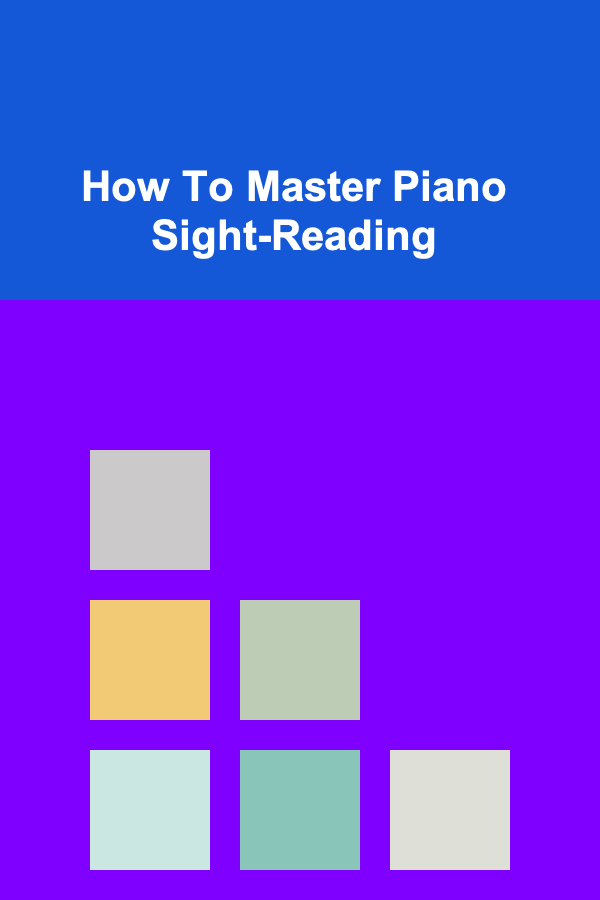
How To Master Piano Sight-Reading
ebook include PDF & Audio bundle (Micro Guide)
$12.99$7.99
Limited Time Offer! Order within the next:

Sight-reading is one of the most crucial skills a pianist can develop. It is the ability to play a piece of music for the first time by looking at the score and playing it without prior preparation. Sight-reading is essential for both beginners and advanced musicians, as it forms the foundation for musical versatility, performance, and learning new pieces quickly. In this article, we will explore effective strategies, techniques, and practice methods to master piano sight-reading.
Understanding Sight-Reading
Sight-reading is not just about playing the correct notes; it involves several musical elements, such as rhythm, dynamics, articulation, phrasing, and tempo. Successful sight-reading requires the ability to read music fluently and quickly, while also interpreting the emotions and intentions behind the written notes. It's the ability to "read" music as if you were reading a language. You not only need to understand what's in front of you but also anticipate what's coming next.
For pianists, sight-reading can be a challenging skill because they must read and play on both treble and bass clefs simultaneously. Moreover, they need to manage multiple voices or hands, interpret harmonic and melodic structures, and adjust to the specific challenges of each piece. Sight-reading combines technical skill with interpretative understanding, which is why it requires consistent practice and patience.
The Challenges of Sight-Reading
There are many challenges involved in mastering sight-reading on the piano. Some of the most common include:
- Reading Two Staves Simultaneously: Unlike some other instruments, pianists must read both the treble and bass clefs, which can be overwhelming for beginners.
- Coordination Between Hands: Pianists must coordinate both hands, which often play different melodies, rhythms, and dynamics. This can be especially tricky in more complex pieces.
- Rhythmic Complexity: Sight-reading involves accurately interpreting rhythms, which may include complex patterns, syncopations, and irregular time signatures.
- Hand Position and Fingering: Sometimes, the notes on the page don't correspond to easy finger placements, requiring the pianist to adjust their hand position or fingering quickly.
- Phrasing and Dynamics: Understanding the emotional intent behind the music and playing with appropriate dynamics and phrasing is a crucial part of sight-reading, which requires more than just playing the notes correctly.
Overcoming These Challenges
To overcome these challenges, pianists must develop several key skills that will make sight-reading easier and more intuitive.
Key Strategies for Mastering Sight-Reading
1. Developing a Strong Foundation in Music Theory
Before diving into sight-reading practice, it's essential to have a strong foundation in music theory. Understanding the basic principles of rhythm, scales, intervals, chord progressions, and key signatures will help you read music more fluently. It will also make it easier to recognize patterns in the music and predict what comes next. This understanding will reduce the cognitive load while sight-reading, allowing you to focus more on the performance aspect.
For instance, understanding how chords are constructed and how they move through progressions will help you anticipate harmonic changes, making it easier to play without stumbling.
2. Practice Regularly With Simple Pieces
When you're starting to improve your sight-reading skills, it's crucial to choose simpler pieces that you can read through easily. By practicing with easier music, you reduce the chance of getting stuck, and you can focus on other aspects such as rhythm, phrasing, and dynamics. Start with pieces that are well within your current playing ability, then gradually increase the difficulty as you gain confidence.
Playing pieces that are too difficult can hinder your progress, as you'll likely find yourself focusing too much on trying to play the correct notes rather than developing your overall sight-reading technique.
3. Focus on Rhythm First
When sight-reading, it's easy to become fixated on playing the right notes, but rhythm is just as important, if not more. Rhythm provides the structure for the entire piece. Without the proper rhythm, even a technically correct performance will sound disjointed and unclear.
Begin your practice sessions by focusing purely on rhythm. Play through simple exercises or pieces while concentrating on maintaining a steady tempo and playing all the rhythms accurately. Use a metronome to ensure you're keeping a consistent pulse, which will also help you deal with tricky time signatures.
4. Practice Hands Separately
One of the common challenges in sight-reading for pianists is managing both hands at the same time. This can often lead to confusion or mistakes, especially when the hands are playing different rhythms or parts. To overcome this challenge, practice the hands separately before combining them.
Start by practicing the right hand (treble clef) and left hand (bass clef) independently. Focus on mastering the fingering, rhythm, and dynamics for each hand. Once you feel confident with both hands separately, combine them and practice sight-reading with both hands together. This gradual approach will help you build the coordination necessary for successful sight-reading.
5. Look Ahead in the Music
One of the most important skills in sight-reading is the ability to look ahead in the music. Instead of focusing solely on the note you're currently playing, try to anticipate the next several notes, rhythms, and phrases. This will help you maintain a continuous flow and avoid interruptions in your performance.
To develop this skill, practice by playing a few notes ahead of where you are. At first, it may feel overwhelming, but over time, you'll be able to anticipate the music more easily. This technique is particularly useful for difficult passages, as it allows you to prepare mentally for the challenges ahead.
6. Avoid Stopping for Mistakes
One of the key principles of sight-reading is to avoid stopping when you make a mistake. Stopping disrupts the flow of the music and can prevent you from building the necessary skills for fluent reading. Instead, if you make a mistake, try to keep going. This will help you build the resilience needed for live performances, where mistakes can happen at any time.
When practicing sight-reading, it's important to focus on maintaining a steady rhythm and flow, even if that means skipping over a few mistakes. The more you practice this mindset, the more comfortable you will become with playing through errors.
7. Analyze the Music Before Playing
Before you begin playing a new piece, take a moment to analyze the score. Look at the time signature, key signature, tempo markings, and dynamic indications. Notice any repeat signs, accidentals, or challenging rhythmic patterns. By familiarizing yourself with these elements beforehand, you'll be able to anticipate any challenges that may arise and prepare yourself mentally for the piece.
Analyzing the structure of the piece, such as recognizing recurring patterns or motifs, will help you play with greater ease and confidence. This preparatory step will also allow you to read more quickly, as your mind will already be familiar with many of the musical elements.
8. Use a Variety of Repertoire
To truly master sight-reading, it's essential to practice a wide variety of music. Different genres and styles present different challenges, and by practicing a diverse range of repertoire, you'll improve your ability to adapt to various musical situations.
Incorporate classical, contemporary, jazz, and even folk music into your practice routine. Each style has its own unique elements, such as jazz chord extensions, contemporary rhythms, or classical counterpoint. Familiarity with various styles will make you a more versatile sight-reader and allow you to approach unfamiliar pieces with greater ease.
9. Set Realistic Goals and Track Your Progress
Sight-reading is a skill that takes time to develop, and it's essential to set realistic goals and track your progress. Rather than trying to tackle complex pieces too quickly, break your goals into smaller, manageable steps. For instance, aim to sight-read a certain number of pieces each week, gradually increasing the difficulty as you improve.
By tracking your progress and recognizing incremental improvements, you'll stay motivated and focused on your long-term goal of mastering sight-reading.
10. Use Technology and Apps
In the digital age, many apps and online resources can help you improve your sight-reading. There are several apps specifically designed for sight-reading practice that provide a wide variety of exercises, music examples, and feedback. These apps often include features like adjustable tempos, customizable difficulty levels, and the ability to practice specific musical elements, such as rhythm or intervals.
Using technology can also help you stay consistent with your practice. Many apps can provide instant feedback on your accuracy and help you develop your skills in a more interactive and engaging way.
Conclusion
Mastering piano sight-reading is a gradual process that requires consistent effort, patience, and a strategic approach. By focusing on building a strong foundation in music theory, practicing regularly with simple pieces, and using a variety of techniques and strategies, you can steadily improve your sight-reading abilities. Keep practicing, stay consistent, and challenge yourself with increasingly difficult pieces, and you will soon find yourself a more confident and capable sight-reader.
Remember that sight-reading is not just about playing the notes; it's about interpreting the music, expressing its emotions, and bringing it to life in real-time. With dedication and practice, you can master this essential skill and unlock a world of musical possibilities.
Reading More From Our Other Websites
- [Home Party Planning 101] How to Throw an Allergy-Friendly Home Party: A Comprehensive Guide
- [Home Maintenance 101] How to Fix a Broken Window Screen and Prevent Future Damage: An Expert's Advice
- [Rock Climbing Tip 101] The Art of Traditional Climbing: Mastering Gear Placement and Route Reading
- [Organization Tip 101] How to Organize Your Memory Box for Keepsakes
- [Home Cleaning 101] How to Clean Your Home's Baseboards and Moldings
- [Sewing Tip 101] Top 10 Must-Have Sewing Needles for Hobbyists and Professionals
- [Personal Investment 101] How to Choose an Online Broker to Maximize Your Investment Strategy
- [Personal Care Tips 101] How to Choose a Mascara That Will Not Irritate Your Eyes
- [Organization Tip 101] DIY Quartz Countertop Repair: Tips for Successful Restoration
- [Digital Decluttering Tip 101] The Science of Screen Time: Balancing Efficiency and Burnout

How to Make Your Home Smell Fresh with Simple Cleaning Tricks
Read More
The Art of Attention: How to Stand Out by Being Present
Read More
How To Understand the Ethics of AI in Gaming
Read More
Researching the Life of Plato and Aristotle: A Deep Dive
Read More
Mastering Your Desires and Aversions: A Deep Dive
Read More
How to Plan a Destination Wedding Checklist: A Comprehensive Guide
Read MoreOther Products

How to Make Your Home Smell Fresh with Simple Cleaning Tricks
Read More
The Art of Attention: How to Stand Out by Being Present
Read More
How To Understand the Ethics of AI in Gaming
Read More
Researching the Life of Plato and Aristotle: A Deep Dive
Read More
Mastering Your Desires and Aversions: A Deep Dive
Read More